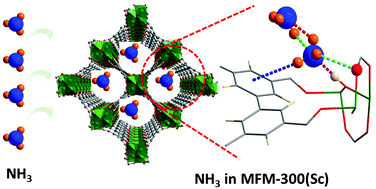High capacity ammonia adsorption in a robust metal–organic framework mediated by reversible host–guest interactions†
Abstract
To understand the exceptional adsorption of ammonia (NH3) in MFM-300(Sc) (19.5 mmol g−1 at 273 K and 1 bar without hysteresis), we report a systematic investigation of the mechanism of adsorption by a combination of in situ neutron powder diffraction, inelastic neutron scattering, synchrotron infrared microspectroscopy, and solid-state 45Sc NMR spectroscopy. These complementary techniques reveal the formation of reversible host–guest supramolecular interactions, which explains directly the observed excellent reversibility of this material over 90 adsorption–desorption cycles.

- This article is part of the themed collections: Celebrating the 200th Anniversary of the University of Manchester and 2022 Pioneering Investigators


 Please wait while we load your content...
Please wait while we load your content...